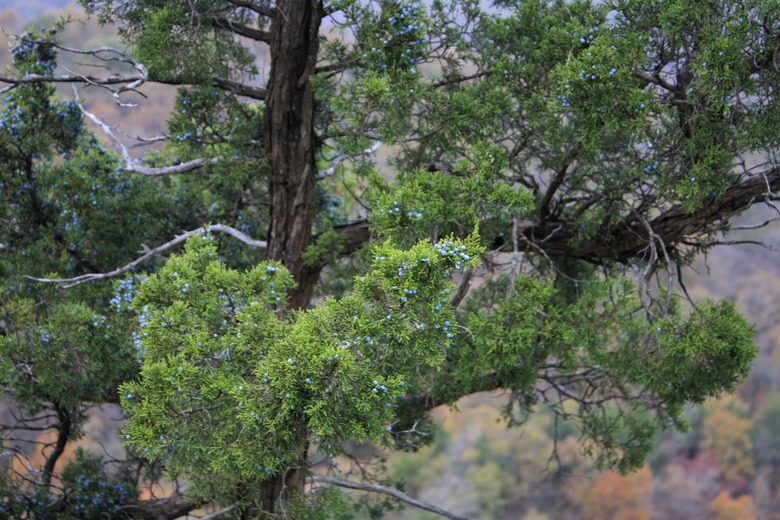Are The Roots Of A Cedar Tree Deep?
Many cedar trees (Cedrus spp.) do not have deep roots, although the Eastern red cedar (Juniperus virginiana, USDA zones 2-9), which grows throughout much of the United States, can penetrate the soil to as much as 25 feet under the right conditions. True cedar trees aren't native to the U.S., although many species grow in the U.S.. Many cedars have shallow, spreading root systems while other species have long taproots.
Tip
Most tree roots, including those of many cedar trees, grow in the top 24 inches of soil. Mature Eastern red cedars, which are not true cedars, can have roots that grow as deep as 25 feet. Some true cedars have long taproots that extend many feet into the ground.
The Eastern Red Cedar
The Eastern Red Cedar
The cedar trees that are native to the U.S. are not true cedars, which belong to the genus Cedrus. However, the trees most Americans think of when they think of cedars are the Eastern red cedar and the Western red cedar (Thuja plicata, USDA zones 5-7). The Eastern red cedar will develop a main root stem that can extend up to 25 feet, according to the U.S. Forest Service.
These adaptable trees flourish throughout much of the U.S., hardy in U.S. Department of Agriculture zones 2 to 9. As the Eastern red cedar ages, however, it will also develop a shallow root system that will extend out as much as 20 feet from the main root stem. That root system often replaces the earlier, deeper root system as the tree gets older.
These trees can also flourish in areas with shallow, rocky soils — whether acidic or alkaline. In this habitat, the tree starts developing a wide root system even in its early years to allow it to survive on rocks and outcroppings. This fibrous root system can adapt well to rocky soils, with root tendrils that grow around rocks.
The Western Red Cedar
The Western Red Cedar
The Western red cedar, hardy in USDA zones 5 to 9, has a more shallow root system than the Eastern red cedar. This tree has roots that are closer to the average of 6 to 8 feet, but its roots spread as far as those of the Eastern red cedar.
A Western red cedar is tough and can go dormant for many years until conditions are right to grow. It can survive and grow in soils that are low in nutrients, but does better on soils with nitrogen, phosphorus and potassium. The roots are deeper than those of Western hemlock, but not as deep as those of Western larch, white pine and Douglas fir.
Rather than a main taproot like the Eastern red cedar, Western red cedars tend to have spreading roots that form a dense network underground to support the tree. These trees grow well on rocky slopes, but in the home garden they prefer moist, acidic, well-drained soils.
True Cedar Trees
True Cedar Trees
Traditional cedar trees are mostly native to the Middle East and Asia, but do well in cultivation in the U.S. Blue atlas cedar (Cedrus atlantica), also known as Atlas cedar, is one such species that is hardy in USDA zones 6 to 9. Its roots usually extend not more than 6 to 8 feet deep. Like most cedars, however, it's healthiest when it has room to spread.
The deodar cedar (Cedrus deodara) is the other common cedar tree. This Asian native is a perennial in USDA zones 7 to 9. Both species of these cedar trees grow well in dry climates once established. Their large root systems help these trees flourish in warm, dry climates, although they also do well in warm, humid climates.
Cedar trees can grow very large in cultivation, so plant them away from your house to give the roots room to spread. And give the trees room to grow. Under the right conditions, the Deodar cedar can grow 60 to 80 feet tall and 30 to 40 feet wide, while the Atlas cedar can grow 40 to 60 feet tall and spread 25 to 40 feet.
References
- Cal Poly Urban Forest Ecosystems Institute: Deodar Cedar
- Inland Valley Garden Planner: Deodar Cedar
- U.S. Forest Service: Thuja plicata
- U.S. Forest Service: Juniperus virginiana
- Better Homes & Gardens: Using Cedar in the Landscape
- Lady Bird Johnson Wildflower Center: Ask Mr. Smarty Plants: Would an Eastern Red Cedar Root System Damage Underground Irrigation Pipes?
- Colorado State University Extension: Healthy Roots and Healthy Trees
